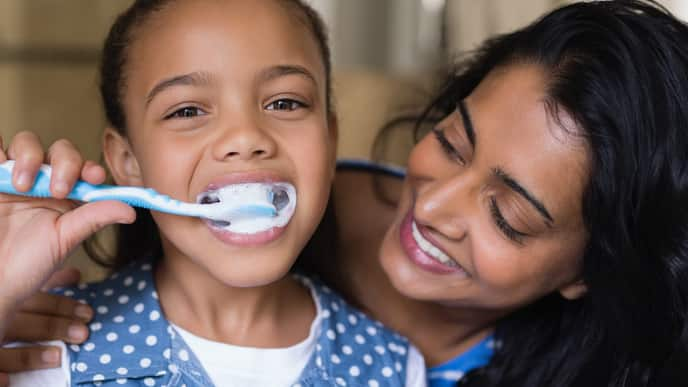Choosing a toothbrush for your child can be daunting when there are so many options. Kids toothbrushes vary in size and shape depending on need and ability, both of which change as they grow. Following a few simple guidelines can help you choose a toothbrush that cleans your child's teeth effectively and encourages good dental care habits in the process.
Children's Toothbrushes
No matter their age, your children's toothbrush should fit comfortably in their mouths and be easy to hold and manipulate. Choose a toothbrush with soft bristles that are made of a round-ended or "polished" material. These types of brush heads clean kids' teeth well but aren't rough on their gums. It's also important that your children's toothbrush appeals to their tastes so that it's fun using it every day and night.
Babies and Toddlers
You should use a damp cloth or gauze on your baby's gums and start using a gentle toothbrush with your baby once their first tooth has erupted, according to the Indian Dental Association. Toothbrushes for babies come in bright colors and have very small heads designed to fit inside your baby's mouth. Brushing your baby's mouth keeps his gums clean and helps acclimate him to a twice-daily toothbrushing routine.
By the age of two, your toddler is likely to want to participate in toothbrushing time. Toddler toothbrushes have small heads and large handles with soft grips that are easy for small hands to hold. At this age, your tot hasn't yet developed the control to brush his own teeth effectively, but he can take a turn before or after Mom or Dad. Powered toothbrushes are available for this age range and older children, and can be engaging and fun for young children to use.
Ages Five to Eight
Between the ages of five and eight, your child is getting ready to be independent about his dental health care. Toothbrushes for kids this age have slimmer handles than toddler toothbrushes in order to suit a child's more dexterous grip and larger jaws. Young children also develop their own skills to clean their teeth effectively, according to the Indian Dental Association, but still require supervision as they brush. Many toothbrushes for children in this age range (and younger) are based on popular cartoon characters, such as the Colgate Kids toothbrushes which are specially designed for children 5 years of age and older who have a combination of baby teeth and adult teeth. Choosing your child's favorite character helps maintain his interest in brushing his teeth.
Preadolescence
Kids aged eight and up can actually brush their teeth themselves. Their toothbrushes look similar to adult products, but still have slightly smaller heads and larger handles. Both powered and manual toothbrushes are appropriate for preadolescent children. Although both types clean teeth and gums equally well, the Indian Dental Association indicates that powered toothbrushes can make the process easier for children and those with physical limitations who might not use proper brushing techniques.
Using Toothbrushes
Kids toothbrushes are essential to good oral health care, but simply buying the right toothbrush for your child doesn't guarantee he will have clean, healthy teeth. Toothbrushes should be used after breakfast and before bed, and teeth should be flossed once a day as soon as two teeth are touching. When the bristles fray and no longer stand up straight – or after three months, whichever comes first – it is time to buy a new toothbrush. Children's toothbrushes often need replacing more frequently than adults', according to the IDA.
Buying the right toothbrush for your child is not only about making sure he has clean teeth and gums; it is about setting up good oral health habits that will last him a lifetime. Follow the age range guidelines on the packaging and involve your child in choosing a new toothbrush, so he has a brush that fits the mouth well and is comfortable to hold and that he loves to use.






